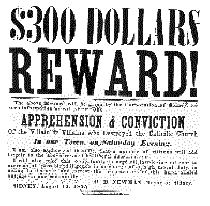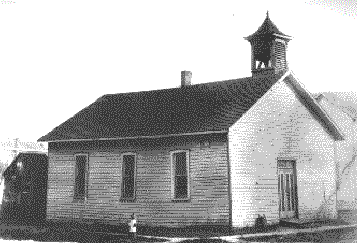|
Mt. Vernon Baptist Church
The roots of the church began in the homes of
two former Randolph slaves shortly after their
settlement in the area in 1846; with the Roger Lee home on Hardin Pike and the Frank Brown
residence located in the area of what is today the Shelby County Fairgrounds on Fair Road,
alternating each Sunday as places of worship. Through the assistance of a circuit rider
minister by the name of Samuel Jones, and the organizational skills of its founding
members: Roger Lee, Frank Brown, Hannah Shelby, Sarah Shelby, and Carter Lee, the new
church was born. 
Paul Cumberland was the first clerk and Mrs. Paul Cumberland and
Mrs. Charles Dickerson were the first candidates for baptism. The first official building
was built on a site that was set aside in Charles Starrett’s originalplat of Sidney for the
purpose of religion, and was located on the corner of South and West Avenues on the
current site of the Monarch Community Center.
Starrett’s plat set aside two such sites with one for the
Presbyterians, and thesecond lot (location of former Armory) not designated. This second
piece of land originally contained a cooper’s shop (in apparent contravention of the
original town plat) that was remodeled to serve as a small Catholic church. This
house of worship was destroyed by a gunpowder blast that provoked a strong response from
the City of Sidney in the form of a poster, printed by the Sidney Journal job office, that
offered a $300 reward for information about the perpetrators. Hitchcock’s "History
of Shelby County" records, "In 1855 this (church) was blown up with gunpowder
and stone during the know-nothing excitement."

The 'colored school' was located south
and slightly east of the Mt. Vernon Baptist Church
and can be seen in this photo.
Picture courtesy of Jim Humphrey.
The Know-Nothing political party’s
(1852-1860) objective was to prevent immigrants and Roman Catholics from holding political
office. They also opposed the Catholic Church. It was a secret organization that attained
its name from the response of members, who, upon questioning about the party, responded,
"I know nothing." In the mid-fifties it elected governors and
legislatures in New York state and four other New England states, however its collapse and
ultimate demise came when it refused, in the 1856 presidential election, to take a stand
on slavery.
Following the destruction of the Catholic church, a new black
church, The Mount Vernon Baptist Church, was erected on the site and remained there until
1912 (pictured above). The Catholic church ‘moved’ to the corner of Main
Avenue and Water Street in 1858.
Hitchcock tells us that in 1913, "The Mount Vernon Baptist
Church, African, is now in the process of building at the corner of Park and Linden
Streets in the northwestern part of the city. The structure is built of cement at a cost
of $3,000 and is modern in all of its appointments, making a splendid church home for its
sixty-five members. The Rev. Hathcock [Haithcock] is the present pastor. The congregation
worshipped for many years at the corner of South and West Avenues in a little frame church
on property bequeathed by Charles Starrett.
The town council bought the lot last year for $1,800 and it has been selected for the new
armory (now the Monarch Community Center) to be built by the state this year of 1913. James
Humphrey indicates that the council sessions to discuss the purchase of the property were
actually held within the old church.
From its Park and Linden Streets location, the church, today, is
active in the spiritual and secular lives of its congregation; supporting a Christian
evangelism that is an integral part of Sidney and Shelby County. Its current pastor is
Reverend J. A. Fleming.
'Black History' segment
written in June, 1998 by David Lodge
[ Back to Black History Index ]
|

